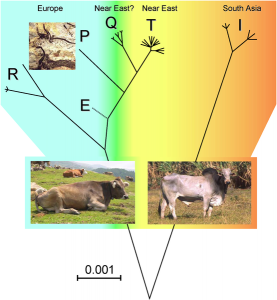- Ecological manifesto cum plant giveway cum art. ‘Nuff said.
- The effects non-native plants have on native plants and pollinators. Say what?
- Old books minable for ancient wisdom. You don’t say.
Nibbles: Guerrilla gardening, Kuwait genebank, Satoyama, Salt and wheat
- From guerrilla gardens to guerrilla flowerboxes.
- “Kuwait needs to have a national genetic bank for plants and seeds by using the help of international experts…”
- Restoration of Satoyama and wetlands by local citizens in Japan.
- Lots of variation in salt tolerance among Georgian wild wheats.
Aurochs alive and well
Well, not quite. But some of their DNA is. A paper just out in PLoS ONE has found two mitochondrial DNA haplogroups (the ones labelled R and P in the diagram below) which apparently got into Italian local breeds from “European aurochsen [haplogroup E] as the result of sporadic interbreeding events with domestic herds grazing in the wild.” Some of these breeds are rare and marginalized, though, so even the last remnants of the aurochs might be in danger.

Why biodiversity matters
Shahid Naeem’s 1 article “Lessons from the Reverse Engineering of Nature” is long, complicated and, in the end, a bit too esoteric for my taste. It also contains a couple of unnecessarily dismissive references to genebanks. But it is worth sticking with for a section which occurs about half way through, and one paragraph in particular.
After describing a number of experiments in which researchers re-created a particular ecosystem, varying only the overall level of biodiversity (this is what he means by reverse engineering nature), Naeem says:
In spite of the limited number of species and tiny numbers of combinations involved, these studies have been stunningly successful at demonstrating that greater diversity means more biomass, more production, greater retention of nutrients, greater resistance to invasive species, greater resistance to the spread of plant pathogens and greater stability.
He goes on to quote a formal meta-analysis, but that succinct summary is definitely worth having to hand the next time someone asks you what species are good for. Naeem is pretty good on the mechanisms too.
Biodiversity loss can affect ecosystem functioning for many reasons, but two keep emerging from the research. First, the more species one removes, the greater the probability that an extraordinarily important species will be lost. But there is a second reason that biodiversity loss reduces ecosystem function: complementarity. The more species you have, the more ways they make use of limited resources such as light, water, nutrients and space.
And what goes for ecosystems goes for agroecosystems, right? Right.
Biodiversity indicators include agrobiodiversity
The 2010 Biodiversity Indicators Partnership has relaunched its website. Not earthshattering news, I agree, but a good opportunity to remind ourselves that, perhaps surprisingly, the list of indicators includes one on ex situ crop collections and another on genetic diversity of terrestrial domestic animals. There’s also an indicator tracking the contribution of biodiversity to nutrition, and another looking at the area of sustainably managed agricultural ecosystems. All in all, not bad for agrobiodiversity. Must have taken a lot of lobbying, though.